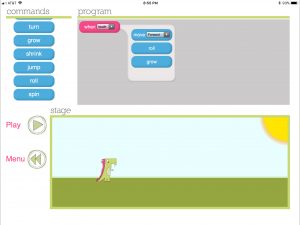Using Daisy the Dinosaur to Support Early Coding Concepts and Computational Thinking
Coding and programming has become a popular trend in education today. It has become recognized that possessing a capacity for perseverance and a skill set to be able to understand the basics of coding and programming can provide individuals with an avenue to explore creativity and innovation in a way students have not before on such a grand scale. Coding and programming fall under the idea of computational thinking. Simply put, computational thinking refers to how individuals can consider ways problems can be approached in a computer context as well as how information can be organized and used and how a computer might use and organize the information. On a larger scale, this video will help demonstrate how innovators are embracing computational thinking to address real issues around the globe.
For more information regarding computational thinking, take a look here!
The question then becomes, what does this look like with our youngest learners? To begin, consider how you organize files on your laptop or computer. I imagine you have them in folders. If you are at all like me, perhaps even folders within folders, within folders. The files within these folders are similar and/or relevant. I keep my documents , photos, and videos, related to my daughter in a folder titled, “Lydia”. Translating this to the early childhood classroom, consider common spaces and routines: art center, reading corner, cubbies, dramatic play, etc. When children enter their classroom, they find their own cubby, they put their own coat on a hook, they may put their lunch on a particular shelf, as well as put their own change of clothes in a particular bin. In the art center they put their scissors with the other scissors and their crayons go in the bin with other crayons. At an early age, they are already beginning to develop the skill to organize items into particular and relevant spaces and places.
By engaging in coding and programming activities, young children can explore foundational concepts such as:
- Sequencing/directions
- Directional coding
- Conditions/If-than statements
- Patterns/Looping
- Problem-based or goal-based design
Daisy the Dinosaur is a free iPad application that invites children to explore early programming and the above skills related to computational thinking. Take a look at this quick video:

You will see that this application is visual and textual at the same time. From an early reader standpoint, this application utilizes high frequency words which would be taught in kindergarten and first grade. As seen, there are two modes, “free-play” and “challenge”. Use what you know about your group to determine how you might introduce this application to them. In my experience, I have found using the “challenge mode” first most successful because it slowly introduces new functions. Once they have developed the understanding of the provided functions, the “free-play” mode is more understandable, intuitive, and of course fun.
Challenge idea: Consider having children create challenge cards for each other. On these cards, they can write/draw their own challenges to code Daisy. Some of the common challenge cards I have observed created include:
- Make Daisy as big as you can
- Make Daisy disappear
- Make Daisy spin for a long time
Have fun!!